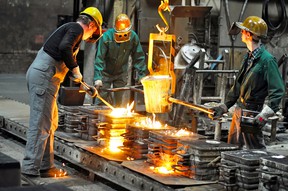Why is Nissan melting motors?
A look at Nissan's new EV motor recycling process, and what it means for you

Article content
With the auto industry pushing towards electrification to help tackle climate change, automakers are playing an ever-increasing role in helping find ways to more affordably and easily recycle the vehicles they build, with energy efficiency front and centre. Japanese automaker Nissan builds the popular Leaf EV (Electric Vehicle), one of the world’s best-selling electric cars. Recently, they announced the start of a joint effort with Waseda University that will create a new process designed to efficiently recover rare-earth compounds from the magnets found in electric car motors.
Advertisement
Article content
Those magnets contain desirable elements like neodymium and dysprosium, known as rare-earth metals. To reduce the environmental impact of mining these metals, Nissan has spent a decade learning how to build motors using less of them. They’ve also been working on developing more effective ways to recover those metals in the recycling process, which reduces the need to dig fresh rare-earth metals out of the ground.
This helps further mitigate the environmental impact of the vehicle through its entire life cycle, and can help protect automakers from fluctuating material costs. In turn, this can drive down the cost of EV motor manufacturing — and ultimately the cost of EV’s themselves — which helps increase adoption.
For years, Nissan has recycled electric motors by manually removing the magnets from rejected motor units that don’t meet production standards and returning them to their suppliers. That’s slow and expensive, and with growth ramping up in the EV market, the manufacturer needed a way to make rare earth metal recovery simpler and more economical. This would help Nissan now, but also help support increased electric motor recycling demand in the future.
Advertisement
Article content
For 5 years, Nissan has been collaborating with Waseda University, which has a strong record of research in metal recycling and smelting. In March of 2020, the joint effort created a pyrometallurgy process that does not require motor disassembly. That’s a fancy way of saying that the motors aren’t taken apart, but simply melted instead.
Unwanted motor units are placed into a receptacle with some other materials, before being heated together to at least 1,400 degrees Celsius. Once thoroughly melted, other chemicals are added at strategic points in time, some complicated processes occur, and eventually, the molten mass separates into two layers just like oil-and-vinegar salad dressing.
That top layer? Those rare-earth metals.
With 98 per cent recovery in half the time (and no need to demagnetize and disassemble the motor), this promising new process will help change the way electric motors are recycled, while lowering their environmental impact and cost.


